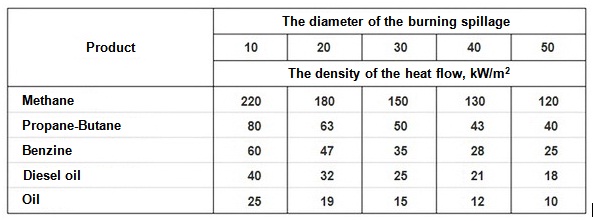|
HEAT RADIATION AT FIRES
The spread of fires
occurs in consequence of the transfer of heat from
the burning zone to surrounding objects. If the diameter of this zone exceeds
0.3-0.5 m, the dominating aspect of heat transfer becomes heat radiation, which
is electromagnetic waves emitted from the burning zone.
This is precisely the cause by which objects outside the burning zone are heated to the ignition temperature, which leads to the spread of fire
(see presented photos).
The heat radiation also has a damaging effect on people: it can cause severe burns and death. Therefore, the protection of people and objects against heat radiation
of fires is one of the most important tasks of fire-fighting.
The provision of protection against heat radiation is especially important in oil- and gas-extracting and oil- and gas-processing industries.
There is a great quantity of combustible products concentrated in relatively small areas. Due to the high combustion heat and the high rate
of burning of these products, the heat radiation from the burning zone has a great intensity.
The attack of this heat radiation on equipment
containing oil, oil products, and liquefied gases leads to the loss of tightness
of this equipment and the escaping of the mentioned products in outer
space, as well as to loss of strength of this equipment and destruction
of one. The result is inflammation of larger and larger volumes of these
products and rapid spread of fire,
which can lead to a large-scale accident with catastrophic consequences.
Of especially danger is the destruction of equipment with explosion
as well as the
formation of a fireball as the result
of ignition of a cloud
consisting of a mixture of air and
vapours of these products.
The allowable value of the intensity (density) of heat radiation (heat flow) that can act on
the unprotected human skin over a long period is taken
to be 1.4 kW per square meter. The heat radiation with higher intensities has dangerous action on mans (as
its intensity increases,
there are overheating, pain, unbearable pain, instantaneous burns, burns with fatal outcome).
The action of heat flow with the density of 4.2 kW per square meter on unprotected human skin in the course of 20 seconds causes unbearable pain;
clothing (cloth), rubber, wood, metal hardware
are not changed.
The action of heat flow with the density of 8.5 kW per square meter on
the unprotected human skin in the course of 20 seconds causes burns (blisters are arising);
clothing (cloth) and rubber are carbonizing, wood is decomposing (volatile substances are giving off), the paint on the metal hardware is bubbling.
The action of heat flow with the density of 10.5 kW per square meter in unprotected human skin causes instantaneous burns; clothing (cloth), rubber,
wood are igniting (ignition of wood arise from ignition of volatile substances), the paint on the metal hardware is burning.
The heat radiation of the flame of burning objects characterized by
an average surface density of heat radiation, which depends on the size and shape
of burning objects (combustion of spillage, combustion of
torch, etc.), the flame temperature and other factors. The density
of the heat flow acting
on objects near the combustion zone depends on the distance at which
these objects
are disposed from this
zone, and some other factors.
The density of the heat flow in case of combustion of spillage of highly inflammable liquids and combustible liquids can be estimated using
the procedure described in Appendix B of the Russia State Standard R12.3.047.
The average surface density of the heat radiation of burning spillages of some
liquefied gases, oil products and oil as a function of the diameter of spillage

|

